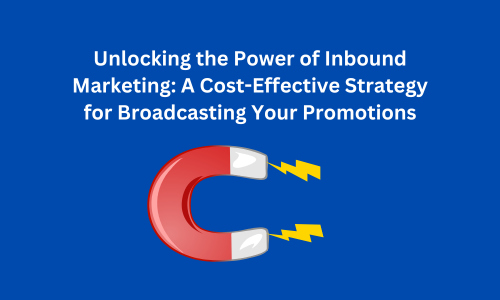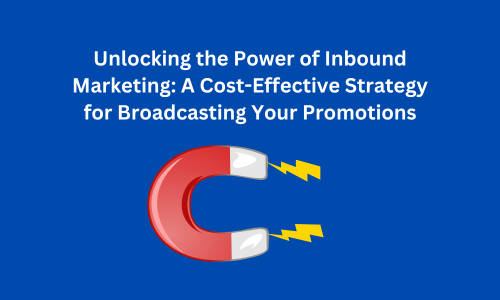


In today’s digital landscape, where marketing budgets are scrutinized and ROI is paramount, businesses are increasingly turning to inbound marketing as a cost-effective and powerful strategy. Unlike traditional outbound methods that often feel intrusive, inbound marketing attracts, engages, and delights your audience in a way that feels natural and valued. Let’s dive into how this approach can be both economical and impactful for broadcasting your promotions across the web.
Inbound marketing is a strategy designed to draw potential customers to your brand through valuable content and experiences, rather than pushing messages out. It’s about creating and sharing content that resonates with your target audience and addresses their needs, interests, and pain points. The goal is to attract, engage, and delight, building a relationship that turns prospects into loyal customers and advocates.
1. Attract: The first step in inbound marketing is to attract the right audience. This is done by creating content that answers their questions, solves their problems, and aligns with their interests. Content marketing—through blogging, e-books, whitepapers, videos, and infographics—plays a pivotal role here. By delivering valuable content, you position your brand as an authority in your industry, drawing potential customers in organically.
2. Engage: Once you’ve attracted visitors to your site, the next phase is to engage them. This involves using content that keeps them interested and encourages them to interact with your brand. Engagement can be fostered through personalized content, social media interactions, and effective email marketing. By building a connection and offering valuable information or solutions, you can guide potential customers through their decision-making process.
3. Delight: The final step is to delight your customers by exceeding their expectations. Provide excellent service, gather feedback, and continue offering valuable content even after a purchase. Happy customers are more likely to become repeat buyers and brand advocates, promoting your business through word-of-mouth and social sharing.
Content Marketing: At the heart of inbound marketing is content. Regularly updated blog posts, informative e-books, engaging videos, and eye-catching infographics not only attract traffic but also build your credibility. By consistently providing useful and relevant content, you create a resource that your audience will return to and share with others.
Search Engine Optimization (SEO): SEO is crucial for making sure your content is discoverable. By conducting thorough keyword research and optimizing your content for both on-page and off-page SEO, you increase your chances of ranking higher on search engine results pages. This means more visibility for your brand and more opportunities to attract organic traffic.
Social Media Marketing: Social platforms are invaluable for spreading your content and engaging with your audience. Tailor your strategy for each platform, share your content, and interact with your followers. Social media not only amplifies your reach but also provides a space for real-time engagement and feedback.
Email Marketing: Email remains a powerful tool in inbound marketing. Personalized email campaigns and automated workflows help nurture leads and keep your audience engaged. By delivering targeted content and offers based on user behaviour, you can effectively guide prospects through the sales funnel.
Cost Efficiency: Compared to traditional outbound marketing methods—like TV ads, print media, or cold calling—inbound marketing is considerably more budget-friendly. Creating content and optimizing it for search engines often requires a lower investment, and the long-term benefits of organic traffic can outweigh the initial costs.
Targeted Reach: Inbound marketing allows you to attract and engage with a highly targeted audience. By tailoring your content to specific interests and pain points, you ensure that you’re reaching those who are most likely to be interested in your products or services.
Long-Term ROI: Inbound marketing strategies build over time, resulting in compounding returns. As you create and optimize content, your audience grows, and your brand’s online presence strengthens. This leads to sustained visibility and ongoing engagement, providing a solid return on your investment.
Create a Content Calendar: Plan and schedule your content to ensure consistent delivery. A content calendar helps you stay organized and ensures you’re addressing various topics and audience needs throughout the year.
Use Analytics Tools: Leverage tools like Google Analytics and social media insights to track the performance of your content and campaigns. Analyzing data helps you understand what works, what doesn’t, and where to make improvements.
Continuously Optimize: Inbound marketing is not a one-time effort. Regularly review and update your content, SEO practices, and engagement strategies to keep up with changing trends and audience preferences.
Consider companies like HubSpot and Moz, which have effectively used inbound marketing to become industry leaders. HubSpot’s blog and educational content attract millions of visitors, while Moz’s extensive SEO resources have made it a go-to authority in search marketing. These examples demonstrate how inbound marketing can transform a brand’s online presence and drive significant business growth.
Additionally, Markethive, an ecosystem for entrepreneurs operating on the decentralized blockchain, offers robust inbound marketing tools to its members. By leveraging Markethive’s blogging platform, email marketing capabilities, and capture page tools, entrepreneurs can effectively promote their businesses and build a strong online presence within a supportive and innovative environment.
Inbound marketing offers a cost-effective and powerful way to broadcast your promotions across the web. By focusing on attracting, engaging, and delighting your audience with valuable content, you not only build meaningful relationships but also achieve sustainable and measurable results. Start harnessing the power of inbound marketing today and watch as your brand’s visibility, credibility, and customer loyalty flourish.
Disclaimer: This article is provided for informational purposes only. It is not offered or intended to be used as legal, tax, investment, financial, or other advice.
